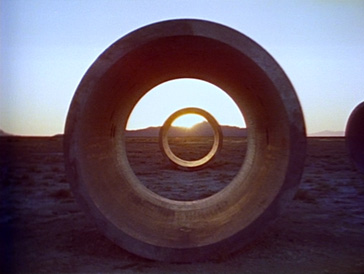
Born in 1938 in Worcester, Massachusetts (US). Died in 2014 in New York (US)

1978
16mm film transferred onto video, colour, sound
durée : 26’31’’
Year of Purchase: 2011
Nancy Holt belongs to a generation of artists from the 1960s who were in awe of the great expanses of the American West: desert and deserted landscapes with millennial geology and archeology. In 1973, the New York artist decided to find a flat stretch of desert surrounded by low mountains which would be an ideal site for an installation of her Sun Tunnels. The site was located in northwestern Utah, in a valley shaped by a vanished prehistorical lake of which the Great Salt Lake is a remnant. The 40 acres she acquired in 1974 are so remote that a trail had to be built to reach it. As was the case for many other Land Art works, Sun Tunnels required the visitor to make a difficult pilgrimage. Yet, how else could one get an idea of the shadows, coolness, and cavernous resonance without having ever strolled through it? To mitigate this relative inaccessibility, the artist engaged a film crew to record the installation process. More than a simple making-of documentary, the resulting film immortalized the site with a few memorable tracking shots. The camera, mounted on a helicopter or a car, orbited around the work, corroborating the essential function of Sun Tunnels: channeling light and framing vision.
The four pipes of reinforced concrete are thus giant telescopes pointed at the sun. Starting in 1972, the artist installed here and there more or less large tubes, or locators which make it possible to see toward and through: sometimes toward cardinal points, sometimes through a sand dune. As one can suspect, like the stones of Stonehenge or the pyramids of Gizeh, the pipes of Sun Tunnels respect the astronomic alignment, in this case calculated so that at dawn and at twilight of winter and summer solstices, the sun rises and sets on the exact axis of each of the tunnels. A plate mounted at the center of the observatory marks the pivoting point where one might position oneself in order to be in the line of view of the sun and to be aligned with its extreme amplitudes. Other stars come to join the solar rite: they perforate each pipe with their constellations.
Even if a shadow of new-age mysticism hovers over this work, the objectives remain concrete: to frame the expanse of the desert in order to humanize its scale, and to be in tune with the Earth’s cycles in order to reveal its rotation. The cosmic mechanism and construction machinery join together in the same primordial consciousness, close to the “prehistoric future” described by the artist Robert Smithson, Nancy Holt’s partner. Just as a backhoe would be an “armored dinosaur” made from materials excavated from the earth, concrete would no longer be the amnesiac substance of modernity but an aggregate of sand and rocks extracted from the ancestral soil. Romanticism and the backhoe are no longer at odds.
Hélène Meisel